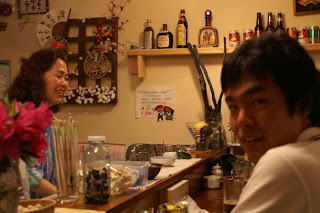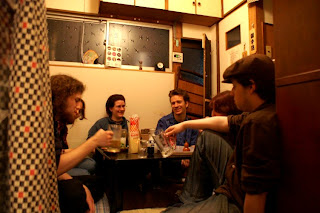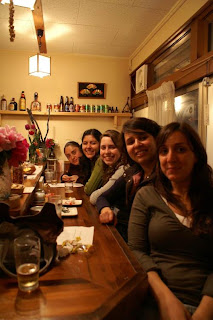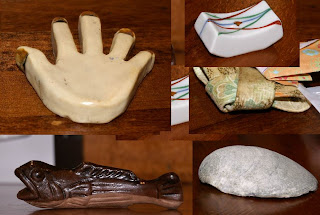the Living Objects
Young people who come to Mummy’s are mostly from KG University. Either somebody invites them, gives them a flayer which Mummy sometimes hands out to customers or they hear of the place from their friends. I asked them, why to they like the place.
KG student: “I like the atmosphere. If I want to relax I come here, if I want to have fun, I go to Daddy’s Shoes (another bar popular among students)”
KG student: “It is not like a typical izakaya. It has this international feeling, because so many foreigners come here.”


A group of regulars. If there are too many people, the backroom with a low table and tatami mats gets opened.

A group of friends stopping by.

Mummy's is a place where foreign students can interact with people not connected to the university, people who live and work around Hirakata. In a sense, it's a place where two very different groups run into each, people who would probably not talk to each other in other situations - the foreign (and Japanese as well, though less) students and not-so-young-anymore residents and workers of Hirakata.
Without help from Pub Mummy's owner and customers, this project would had been impossible. ありがとうございます。
Blogs by other people in the class:
Build Japan!
Hirakata: the back side of Kansai Gaidai
William's project
Martial Arts in JapanJapanese Labels
Colorful Japan
Japanese Idle
Japan explored
KG student: “I like the atmosphere. If I want to relax I come here, if I want to have fun, I go to Daddy’s Shoes (another bar popular among students)”
KG student: “It is not like a typical izakaya. It has this international feeling, because so many foreigners come here.”

A group of regulars. If there are too many people, the backroom with a low table and tatami mats gets opened.

A group of friends stopping by.
Mummy's is a place where foreign students can interact with people not connected to the university, people who live and work around Hirakata. In a sense, it's a place where two very different groups run into each, people who would probably not talk to each other in other situations - the foreign (and Japanese as well, though less) students and not-so-young-anymore residents and workers of Hirakata.
Without help from Pub Mummy's owner and customers, this project would had been impossible. ありがとうございます。
Blogs by other people in the class:
Build Japan!
Hirakata: the back side of Kansai Gaidai
William's project
Martial Arts in JapanJapanese Labels
Colorful Japan
Japanese Idle
Japan explored
By am On 2007年5月18日金曜日 At 11:15




